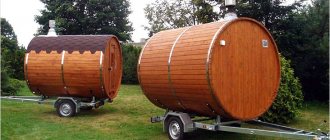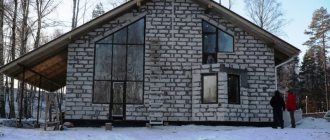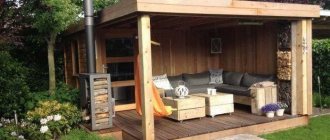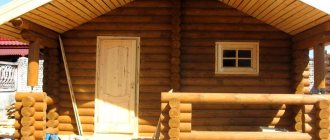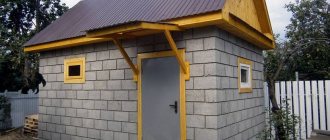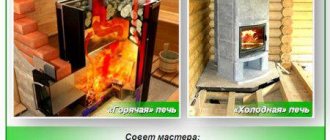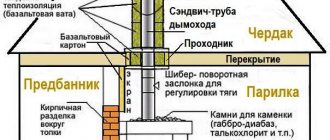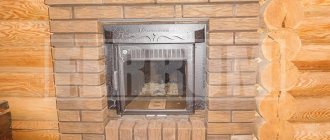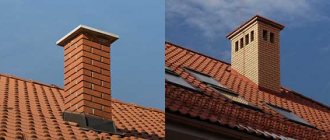A bathhouse is not just a place to relax, but a way to improve your health and well-being. If you choose the right stones for a bath, the beneficial vapors emanating from the hot stones will help cope with diseases and speed up recovery.
But buying to save money increases the risk that the stones will contain radioactive elements and other harmful particles that are life-threatening.
We will talk about all aspects of choosing the appropriate material for a sauna stove and sauna decoration in this article.
Features of the decorative lining of the stove
High-quality finishing of a sauna stove must meet basic operational requirements: withstand high humidity, temperature changes, ensure durability and safety of the surface. The lined stove should quickly heat the bath rooms and create a comfortable microclimate inside.
Lining a stove in a bathhouse has a number of advantages, including the following:
- fast and uniform heating of rooms;
- heat accumulation for a long time;
- minimal risk of getting burned from a heated oven;
- the air does not dry out;
- simplicity and accessibility of maintenance of finished cladding;
- attractive appearance of heating equipment;
- resistance to mechanical damage and deformation.
Types of stove lining
In addition to the fact that the stove is the main heating equipment, it also performs an aesthetic function.
The cladding of the sauna stove is made using practical and durable decorative materials:
- ceramic tiles;
- refractory bricks;
- artificial and natural stone;
- decorative plaster;
- tiles;
- frame made of metal plates.
All materials are distinguished by high performance characteristics and installation features.
Ceramic tiles - elegance and durability
The best material for lining a sauna stove is ceramic tiles. It is easy to install, affordable and durable.
The following types of tiles are used for facing work:
- Clinker room. It is made from red clay with the addition of fireclay, melting agent and dye.
- Majolica. Material with a pressed base, covered with a protective glaze layer. This type of tile is distinguished by its rich color scheme, decorative patterns and ornaments.
- Terracotta. A facing material whose performance characteristics are similar to majolica. Important differences are the porous structure and the absence of a protective glaze. Terracotta is characterized by durability, increased strength and resistance to mechanical damage. This type of tile is made in a round shape.
- Marble. This material is distinguished by its increased wear resistance, practicality and ease of installation, and is devoid of almost all disadvantages.
When choosing this type of finishing, stove owners ask themselves the important question of which tiles are best for covering heating equipment. Experts believe that the best option is a material that has a minimum coefficient of thermal expansion and a dense structure - clinker tiles.
Firebrick: reliability and safety
Decorating a sauna stove with brick is the simplest and most budget-friendly option for owners who decide to do the cladding themselves.
The material has a number of advantages:
- fast and safe heating;
- accumulation and maintenance of heat for a long time;
- resistance to high moisture;
- low cost and ease of installation.
Work on lining the stove in a bathhouse with bricks consists of arranging a reliable decorative screen around the entire perimeter of the equipment. To increase aesthetics and attractiveness, it is allowed to combine materials of different colors.
To fill the joints, it is recommended to use grout that is resistant to high moisture and temperature changes.
Artificial and natural stone: exquisite nobility
The main advantage of cladding with decorative stone is the creation of a noble and attractive appearance. High strength, durability, environmental friendliness, resistance to high temperatures, a variety of color palettes and textures allow the material to be used for finishing bath rooms.
The following types of stones are used for facing work:
Decorative stones can withstand an unlimited amount of heating; they accumulate thermal energy well and maintain a given temperature for a long time. In addition, this material is resistant to acids and alkalis.
In terms of their performance characteristics, artificial elements are not inferior to natural stones. With their help, you can qualitatively line a stove in a steam room or a fireplace in your home.
The technology for laying stones is simple and therefore does not require additional preparation. Non-standard shapes of elements can cause some difficulties during the fitting process, so before installation it is recommended to lay out the material on a flat base. The stones are numbered and fixed on the surface of the furnace using an adhesive composition.
Decorative plaster: simplicity and accessibility
A simple option for lining a Russian stove is plastering the surfaces. Over time, the decorative and protective properties of the plaster composition decrease, which will require frequent renewal of the cladding.
Important! Decorative plaster is used only for brick stoves and is not suitable for metal devices.
Plastering a stove in a bathhouse is simple; all work is performed in the following order:
- the surface is cleaned of dust, debris and remains of the connecting solution;
- the seams are cleared to a depth of 10 mm;
- Before the cladding begins, the oven warms up;
- a mesh of metal rods is installed on the surface with wire fixation;
- the surface is moistened and a primary layer of plaster mixture is applied;
- After the plaster has hardened, a second layer is applied.
The thickness of each subsequent layer does not exceed 6 mm. The plaster solution is applied using a trowel and leveled over the surface with a spatula. When plastering the surface, it is necessary to avoid the appearance of defects - air bubbles and sagging.
After hardening, the top layer is thoroughly cleaned until a smooth surface is obtained.
Tiles: originality and practicality
The use of tiles is an ancient method of cladding stove equipment for a bath. Tiles are tiles made from pottery plastic clay by firing in a kiln at a temperature of more than 1000 degrees. On the back of the tile there are pumps designed to fix the material on any surface. Tiles are presented in several categories:
- with a smooth surface;
- majolica;
- with glazed surface;
- with a relief surface.
Tiles are distinguished by high performance characteristics - durability, practicality, strength and high heat transfer.
The work of tiling should be entrusted to professionals who will do a good job of installing the material on the surface of the stoves.
Metal frame: accessibility and safety
A sauna stove can be lined with a metal frame, which is installed on top of the device and covered with protective shields. The steel frame provides reliable protection for the furnace portal and an optimal level of heating of the air in the room.
This type of cladding has the following advantages:
- accumulates released thermal energy;
- quickly heats the air and walls in the room;
- It is distinguished by its affordable price and ease of installation.
A serious drawback of such cladding is the likelihood of burns upon direct contact with the surface. Therefore, experts do not recommend installing metal frames for stoves in bathhouses in order to avoid possible injuries.
A competent choice of decorative material for cladding and adherence to the technological process will ensure the correct operation of the sauna stove and the creation of a comfortable microclimate in the premises.
Using tiles
The tiles on the stove in the bathhouse are afraid of thermal expansion, therefore, when performing work, it is important to carefully follow the technological process. The lining of the stove in the bathhouse does not tolerate negligence.
Typically, 7 types of tiles are used for cladding:
- Terracotta is a tile that has not been glazed. It consists of terracotta clay and fireclay, which are mixed in a certain ratio. Such tiles have been known for several centuries. A correctly implemented technological process greatly influences the final quality of the material. This tile can be easily recognized by its characteristic red tint.
- Clinker tiles - clay is the main raw material. The material is obtained by pressing, then it is fired at a temperature of +1200 0 C. The crystal lattice of the clay changes and the tile acquires the properties of ceramics.
- Majolica is very difficult to produce. Previously, only manual labor was used for drawing. Now there are industrial designs. The glaze on the tile is obtained by firing. Properties resemble terracotta tiles.
- Tiles are the most preferred option due to the air gap between the tiles and the oven wall. This layer works as an additional heat insulator, allowing the stove to retain heat near itself even longer.
- Porcelain tiles can also be used for lining a stove. Marble chips added during the production of porcelain stoneware give the material unique decorative properties and high strength. Due to this, porcelain tiles are rapidly gaining popularity.
- Fireclay is able to withstand direct exposure to fire. Fireclay is pressed into blanks and fired at a temperature of +1300 0 C.
- Tile - only a material with a high heat resistance coefficient can withstand temperature loads.
Instructions
Do-it-yourself tiling of a sauna stove is done as follows:
- It is necessary to properly prepare the surface. All traces of old finishes must be removed from the wall. Each seam should be selected at 10-15 mm.
- We dilute a deep penetration primer and add marble chips to it. Carefully prime the surface. Do not forget that the primer must dry (at least 24 hours).
- We stretch and fix the metal mesh using dowels. Such reinforcement will significantly increase the strength of the structure.
- The tiles should not be laid on an uneven surface. We level the wall with plaster. We recommend using stove mortar that is specifically designed for plastering stoves. The plaster must be allowed to dry for 48 hours.
- Apply the facing adhesive evenly to the entire surface of the tile. Carefully cover the surface of the stove and press lightly. The tiles can be leveled in about 10 minutes. Then the glue will set. We check the correctness of the masonry using a level. The glue layer should not exceed 1 cm. To make the seams even, we use special crosses. The thickness of the seam is 2-3 mm.
- When the glue dries, we grout the joints.
What tool will you need for the job?
During plastering work, you cannot do without special tools. For such a process you will need:
Set of tools for plastering the stove
- Plastering hammer. It is used for driving special plaster nails.
- Hammer-fist. It is necessary for striking a trojan, chisel or cog.
- Metal cutting scissors - they are used to cut reinforcing mesh. These scissors have a special shape that allows you to save your hands from injury.
- Trowel (trowel). With this tool, the solution is applied and distributed over the surface of the furnace walls.
- Spatulas are used in different sizes - they are used to apply and smooth the solution in difficult places.
- Grater. This tool smoothes surfaces, removing serious defects. It is used for rough grouting.
- The trowel is used for better leveling of plaster for painting.
- Ironing iron. This tool is similar to a grater and is used for the same thing, but has a soft rubber working surface.
- Brushes of various sizes are designed for cleaning tools, applying plaster and adding decorative texture.
- A chisel is used to make notches when preparing walls for plaster, if reinforcing mesh is not used.
- Metal brushes, which are designed for cleaning surfaces when removing old coatings.
- Plumb line - it is necessary to check the evenness of the vertical application of plaster.
- The construction level is used to verify the verticality and horizontality of planes.
- The rule is that this tool is used to level large areas of surfaces along the beacons.
Finishing the stove with bricks
Traditionally, the stove lining is made with brick. This material is also suitable for wooden walls near the stove. It is an additional heat accumulator.
The following types of bricks are used for cladding the stove:
- ordinary ceramic brick (solid);
- refractory fireclay brick.
It is not recommended to use silicate and hollow bricks. It will not hold heat well and will collapse. Fireclay brick is preferable to use, but it is more expensive.
Instructions
- The laying is done using a mortar specially designed for ovens. It will ensure optimal structural strength.
- The foundation design must be designed to withstand such a load. Otherwise, you will have to make a separate foundation.
- The masonry is done in half a brick. The brick is placed on the bed. We start laying from the corner, bandaging 1/3.
- For heat exchange, ventilation holes must be provided in the masonry.
- Between the rows we reinforce the masonry with mesh.
- After completing the masonry, we perform jointing.
Examples of brick lining a stove in a bathhouse in the photo:
Conclusion
The choice of one or another material for lining the stove in the bathhouse is determined by the result that needs to be obtained in the end. The most interesting option in terms of heat preservation is tiling, but it is also the most labor-intensive and expensive. If you want to veneer your stove cheaply, there is such an opportunity.
The most budget option is plastering the stove. It is best to line a metal stove with bricks. This will significantly increase the heat capacity of the oven and it will take longer to cool down.
Another great option is porcelain tiles. When deciding how to line a stove in a bathhouse, pay attention to the quality of the materials used.
To insulate the space around the stove, it is advisable to use mineralite. This is an excellent sauna cover. They are used for lining the sauna - covering wooden walls, although these slabs can also be used to cover a house.
Using the step-by-step instructions in this article, you can not only choose the right material in the best way, but also do the lining of the stove itself and its surfaces with your own hands. This became the main purpose of this material.
Do-it-yourself finishing of a metal stove in a bathhouse with bricks and tiles
There is no bathhouse without a stove, so it must be included in any project. Usually they install a wood-burning stove, which can work as a heater to generate steam in the steam room. The boiler only copes with the heating function, but does not produce steam. If there is little firewood in the region, then they install the lowest-power heater, and compensate for the lack of heat with a boiler.
The sauna stove can be either ready-made or built independently from brick. In any case, finishing of the stove in the bathhouse is necessary. It is required as it protects wooden walls from overheating. You can finish either the stove or the walls, or both. The stove cannot be used without finishing, except in very rare cases when the stove is located in the middle of the room.
Finishing the stove in the bathhouse with various materials
The finishing around the stove in the bathhouse can only be made from safe fire-resistant materials. The most common one is brick, but this is not necessary. Other materials are also suitable:
- Red stove brick, decorative facing brick;
- Tiles, ceramic products for decorating fireplaces;
- Natural stone: various slabs and tiles made from it;
- Decorative plasters (applied only with a thick fire-retardant layer);
- Steel fire-retardant finish (requires good design work).
As you can see, the choice of materials is quite large. Brick is reliable and practical. The rest of the materials are taken either because of the design, or when the budget for bricks is not enough, but another fire-retardant material is already available. We will consider the finishing of each type of material in more detail.
Catalog with prices of products offered by DecorBrisk
White decorative stone 100 size 19/4.5/0.7
White decorative stone 100 (size 19/4.5/0.7) for interior and exterior decoration.
Decorative stone price
300 rub.
Buy stone 100 size 19/4.5/0.7
White decorative stone 100 size 21/6.5/1
White decorative stone 100 (size 21/6.5/1) for interior and exterior decoration.
Decorative stone price
350 rub.
Buy stone 100 size 21/6.5/1
White decorative stone 101 size 19/4.5/0.7
White decorative stone 101 (size 19/4.5/0.7) for interior and exterior decoration.
Decorative stone price
350 rub.
Buy stone 101 size 19/4.5/0.7
White decorative stone 101 size 21/6.5/1
White decorative stone 101 (size 21/6.5/1) for interior and exterior decoration.
Decorative stone price
400 rub.
Buy stone 101 size 21/6.5/1
White decorative stone 102 size 19/4.5/0.7
White decorative stone 102 (size 19/4.5/0.7) for interior and exterior decoration.
Decorative stone price
350 rub.
Buy stone 102 size 19/4.5/0.7
White decorative stone 102 size 21/6.5/1
White decorative stone 102 (size 21/6.5/1) for interior and exterior decoration.
Decorative stone price
400 rub.
Buy stone 102 size 21/6.5/1
White decorative stone 103 size 19/4.5/0.7
White decorative stone 103 (size 19/4.5/0.7) for interior and exterior decoration.
Decorative stone price
350 rub.
Buy stone 103 size 19/4.5/0.7
White decorative stone 103 size 21/6.5/1
White decorative stone 103 (size 21/6.5/1) for interior and exterior decoration.
Decorative stone price
400 rub.
Buy stone 103 size 21/6.5/1
White decorative stone 104 size 19/4.5/0.7
White decorative stone 104 (size 19/4.5/0.7) for interior and exterior decoration.
Decorative stone price
350 rub.
Buy stone 104 size 19/4.5/0.7
White decorative stone 104 size 21/6.5/1
White decorative stone 104 (size 21/6.5/1) for interior and exterior decoration.
Decorative stone price
400 rub.
Buy stone 104 size 21/6.5/1
White decorative stone 105 size 19/4.5/0.7
White decorative stone 105 (size 19/4.5/0.7) for interior and exterior decoration.
Decorative stone price
350 rub.
Buy stone 109 size 19/4.5/0.7
White decorative stone 105 size 21/6.5/1
White decorative stone 105 (size 21/6.5/1) for interior and exterior decoration.
Decorative stone price
400 rub.
Buy stone 105 size 21/6.5/1
White decorative stone 106 size 19/4.5/0.7
White decorative stone 106 (size 19/4.5/0.7) for interior and exterior decoration.
Decorative stone price
350 rub.
Buy stone 106 size 19/4.5/0.7
White decorative stone 106 size 21/6.5/1
White decorative stone 106 (size 21/6.5/1) for interior and exterior decoration.
Decorative stone price
400 rub.
Buy stone 106 size 21/6.5/1
White decorative stone 107 size 19/4.5/0.7
White decorative stone 107 (size 19/4.5/0.7) for interior and exterior decoration.
Decorative stone price
350 rub.
Buy stone 107 size 19/4.5/0.7
White decorative stone 107 size 21/6.5/1
White decorative stone 107 (size 21/6.5/1) for interior and exterior decoration.
Decorative stone price
400 rub.
Buy stone 107 size 21/6.5/1
Red decorative stone 108 size 19/4.5/0.7
Red decorative stone 108 (size 19/4.5/0.7) for interior and exterior decoration.
Price of red decorative stone
350 rub.
Buy stone 108 size 19/4.5/0.7
Red decorative stone 108 size 21/6.5/1
Red decorative stone 108 (size 21/6.5/1) for interior and exterior decoration.
Price of red decorative stone
400 rub.
Buy stone 108 size 21/6.5/1
Red decorative stone 109 size 19/4.5/0.7
Red decorative stone 109 (size 19/4.5/0.7) for interior and exterior decoration.
Price of red decorative stone
350 rub.
Buy stone 109 size 19/4.5/0.7
Red decorative stone 109 size 21/6.5/1
Red decorative stone 109 (size 21/6.5/1) for interior and exterior decoration.
Price of red decorative stone
400 rub.
Buy stone 109 size 21/6.5/1
Red decorative stone 110 size 19/4.5/0.7
Red decorative stone 110 (size 19/4.5/0.7) for interior and exterior decoration.
Price of red decorative stone
350 rub.
Buy stone 110 size 19/4.5/0.7
Red decorative stone 110 size 21/6.5/1
Red decorative stone 110 (size 21/6.5/1) for interior and exterior decoration.
Price of red decorative stone
400 rub.
Buy stone 110 size 21/6.5/1
Red decorative stone 111 size 19/4.5/0.7
Red decorative stone 111 (size 19/4.5/0.7) for interior and exterior decoration.
Price of red decorative stone
350 rub.
Buy stone 111 size 19/4.5/0.7
Red decorative stone 111 size 21/6.5/1
Red decorative stone 111 (size 21/6.5/1) for interior and exterior decoration.
Price of red decorative stone
400 rub.
Buy stone 111 size 21/6.5/1
Red decorative stone 112 size 19/4.5/0.7
Red decorative stone 112 (size 19/4.5/0.7) for interior and exterior decoration.
Price of red decorative stone
350 rub.
Buy stone 112 size 19/4.5/0.7
Red decorative stone 112 size 21/6.5/1
Red decorative stone 112 (size 21/6.5/1) for interior and exterior decoration.
Price of red decorative stone
400 rub.
Buy stone 112 size 21/6.5/1
Brown decorative stone 113 size 19/4.5/0.7
Brown decorative stone 113 (size 19/4.5/0.7) for interior and exterior decoration.
Price of brown decorative stone
350 rub.
Buy stone 113 size 19/4.5/0.7
Brown decorative stone 113 size 21/6.5/1
Brown decorative stone 113 (size 21/6.5/1) for interior and exterior decoration.
Price of brown decorative stone
400 rub.
Buy stone 113 size 21/6.5/1
Brown decorative stone 114 size 19/4.5/0.7
Brown decorative stone 114 (size 19/4.5/0.7) for interior and exterior decoration.
Price of brown decorative stone
350 rub.
Buy stone 114 size 19/4.5/0.7
Brown decorative stone 114 size 21/6.5/1
Brown decorative stone 114 (size 21/6.5/1) for interior and exterior decoration.
Price of brown decorative stone
400 rub.
Buy stone 114 size 21/6.5/1
Brown decorative stone 115 size 19/4.5/0.7
Brown decorative stone 115 (size 19/4.5/0.7) for interior and exterior decoration.
Price of brown decorative stone
350 rub.
Buy stone 115 size 19/4.5/0.7
Brown decorative stone 115 size 21/6.5/1
Brown decorative stone 115 (size 21/6.5/1) for interior and exterior decoration.
Price of brown decorative stone
400 rub.
Buy stone 115 size 21/6.5/1
Brown decorative stone 116 size 19/4.5/0.7
Brown decorative stone 116 (size 19/4.5/0.7) for interior and exterior decoration.
Price of brown decorative stone
350 rub.
Buy stone 116 size 19/4.5/0.7
Brown decorative stone 116 size 21/6.5/1
Brown decorative stone 116 (size 21/6.5/1) for interior and exterior decoration.
Price of brown decorative stone
400 rub.
Buy stone 116 size 21/6.5/1
Brown decorative stone 117 size 19/4.5/0.7
Brown decorative stone 117 (size 19/4.5/0.7) for interior and exterior decoration.
Price of brown decorative stone
350 rub.
Buy stone 117 size 19/4.5/0.7
Brown decorative stone 117 size 21/6.5/1
Brown decorative stone 117 (size 21/6.5/1) for interior and exterior decoration.
Price of brown decorative stone
400 rub.
Buy stone 117 size 21/6.5/1
Brown decorative stone 118 size 19/4.5/0.7
Brown decorative stone 118 (size 19/4.5/0.7) for interior and exterior decoration.
Price of brown decorative stone
350 rub.
Buy stone 118 size 19/4.5/0.7
Brown decorative stone 119 size 19/4.5/0.7
Brown decorative stone 119 (size 19/4.5/0.7) for interior and exterior decoration.
Price of brown decorative stone
350 rub.
Buy stone 119 size 19/4.5/0.7
Brown decorative stone 119 size 21/6.5/1
Brown decorative stone 119 (size 21/6.5/1) for interior and exterior decoration.
Price of brown decorative stone
400 rub.
Buy stone 119 size 21/6.5/1
Brown decorative stone 120 size 19/4.5/0.7
Brown decorative stone 120 (size 19/4.5/0.7) for interior and exterior decoration.
Price of brown decorative stone
350 rub.
Buy stone 120 size 19/4.5/0.7
Brown decorative stone 120 size 21/6.5/1
Brown decorative stone 120 (size 21/6.5/1) for interior and exterior decoration.
Price of brown decorative stone
400 rub.
Buy stone 120 size 21/6.5/1
Gray decorative stone 121 size 19/4.5/0.7
Gray decorative stone 121 (size 19/4.5/0.7) for interior and exterior decoration.
Price of gray decorative stone
350 rub.
Buy stone 121 size 19/4.5/0.7
Gray decorative stone 121 size 21/6.5/1
Gray decorative stone 121 (size 21/6.5/1) for interior and exterior decoration.
Price of gray decorative stone
400 rub.
Buy stone 121 size 21/6.5/1
Gray decorative stone 122 size 19/4.5/0.7
Gray decorative stone 122 (size 19/4.5/0.7) for interior and exterior decoration.
Price of gray decorative stone
350 rub.
Buy stone 122 size 19/4.5/0.7
Gray decorative stone 122 size 21/6.5/1
Gray decorative stone 122 (size 21/6.5/1) for interior and exterior decoration.
Price of gray decorative stone
. 400 rub.
Buy stone 122 size 21/6.5/1
Gray decorative stone 123 size 19/4.5/0.7
Gray decorative stone 123 (size 19/4.5/0.7) for interior and exterior decoration.
Price of gray decorative stone
350 rub.
Buy stone 123 size 19/4.5/0.7
Gray decorative stone 124 size 19/4.5/0.7
Gray decorative stone 124 (size 19/4.5/0.7) for interior and exterior decoration.
Price of gray decorative stone
350 rub.
Buy stone 122 size 19/4.5/0.7
Gray decorative stone 123 size 21/6.5/1
Gray decorative stone 123 (size 21/6.5/1) for interior and exterior decoration.
Price of gray decorative stone
400 rub.
Buy stone 123 size 21/6.5/1
Gray decorative stone 124 size 21/6.5/1
Gray decorative stone 124 (size 21/6.5/1) for interior and exterior decoration.
Price of gray decorative stone
400 rub.
Buy stone 124 size 21/6.5/1
Yellow decorative stone 125 size 19/4.5/0.7
Yellow decorative stone 125 (size 19/4.5/0.7) for interior and exterior decoration.
Price of yellow decorative stone
350 rub.
Buy stone 125 size 19/4.5/0.7
Yellow decorative stone 125 size 21/6.5/1
Gray decorative stone 125 (size 21/6.5/1) for interior and exterior decoration.
Price of yellow decorative stone
400 rub.
Buy stone 125 size 21/6.5/1
Decorative slate Scala 200
Decorative slate Scala 200 white, size 36/8.5/1.52 for interior and exterior decoration.
Decorative slate price
600 rub.
Buy slate Skala 200
Decorative slate Scala 201
Decorative slate Scala 201 white, size 27/8.5/1.5, for interior and exterior decoration.
Decorative slate price
600 rub.
Buy slate Skala 201
Decorative slate Scala 202
Decorative slate Scala 202 gray color size 36/8.5/1.52 for interior and exterior decoration.
Decorative slate price
650 rub. 600 rub.
Buy slate Skala 202
Decorative slate Scala 203
Decorative slate Scala 203 gray color size 27/8.5/1.52 for interior and exterior decoration.
Decorative slate price
650 rub. 600 rub.
Buy slate Skala 203
Decorative slate Light 300
Decorative slate Light 300 white, size 40/9.5/1.5 for interior and exterior decoration.
Decorative slate price
600 rub.
Buy slate Light 300
Decorative slate Light 301
Decorative slate Scala 301 beige color, size 40/9.5/1.5 for interior and exterior decoration.
Decorative slate price
700 rub.
Buy slate Light 301
Decorative slate Light 302
Decorative slate Scala 300 brown, size 40/9.5/1.5 for interior and exterior decoration.
Decorative slate price
700 rub.
Buy slate Light 302
Benefits of brick
This solution can be seen in almost any bathhouse. The brick finish protects the wall from overheating. Very often this protection is made even more powerful and extended to the floor. Finishing the stove in a bathhouse with brick performs both a protective and decorative function. For it, the same type of brick is taken as for the rest of the stove, or another facing brick of the required appearance is additionally purchased.
The rules for brickwork for walls, the stove and the protective portal around the stove are general.
Strict adherence to row levels and neat and thin seams are necessary.
On the walls and in the oven, bricks are laid with overlapping seams. If the portal is laid out in one layer, then it is not at all necessary to comply with this requirement. This is why you can often see protective portals where bricks are stacked on top of each other.
The horizontal row is checked by level. Covering the wall with bricks is plumb. For a corner stove, three planes are laid out with bricks, two on the walls and one on the floor.
For a stove near the wall, there are only two, of which one is located on the floor, and the second is on one wall. Brick, even if it is laid in one layer, has good thermal insulation ability. Its masonry is carried out directly on wooden walls and floors without other fire-retardant insulation.
It is advisable to lay out the horizontal part of the portal in one row between the foundation of the furnace and the subsequent masonry next to it. This advice should only be followed with brick sauna stoves. It is not suitable for metal ones.
In baths, thick fireproof cardboard, mineralite or basalt wool are most often used. There are also basalt cardboard and other materials that are a variation of the previous ones. Minerite is the most preferred. These are ready-made boards specially designed for thermal protection in areas around stoves.
Rules for caring for stones
It is important to carry out regular cleaning and inspection.
The need to replace the stove filler may be indicated by the appearance of an unpleasant odor, minimal heat transfer, or poor steam formation.
In regularly used saunas, minerals are inspected every month.
Care instructions:
- Clean off dirt with a metal brush.
- Rinse in a container with clean water without using soap solution or powder.
- A clean stone should be left in water for up to 1.5 hours until it becomes slippery.
- It is recommended to dry the minerals in a well-ventilated area, otherwise fungus will begin to form on the surface.
- Each element should be lightly tapped with a hammer. A loud sound indicates durability and serviceability, a dull sound indicates the need for replacement.
- Cracked specimens must be removed, filling the oven with new ones.
- Oil stains are practically impossible to remove, so the stones are placed with the clean side up.
For a pleasant aroma inside the steam room, you can hang bouquets of lavender and mint on the walls, fill a container with water and essential oil and hang it over the stove.
Ceramic tile
Ceramic tiles have the same fire resistance as brick.
At the same time, she simply has an incomparably greater variety of appearances.
Now, instead of tiles, almost all manufacturers have mastered the technology of semi-dry pressing, which allows you to create any designs and textures on the surface of the tiles.
This material received the trade name “Porcelain stoneware”, although it does not contain granite. Finishing a stove in a steam room with tiles has its advantages, and the main one is the variety of design solutions. Unlike brick, tiles can be any color.
The side of the old tile had a size of 10-15 cm. With modern porcelain tiles, the side length can reach 40 cm. The longer the side, the more accurate the coating. It has fewer seams, but the complexity of installation increases significantly. Porcelain tiles should be laid by specialists.
This requires a lot of experience. If the tiles are small, you can do the tiling yourself. There are no particular difficulties here. Laying is carried out using a conventional solution on a sheet of heat insulation. It is better to use a special solution based on a dry construction mixture for the appropriate purpose.
Natural stone is as fire resistant as brick. It is equally suitable for finishing a stove, but its appearance is much more decorative.
The finishing of the stove is carried out not with raw stone, but with finished products made from it. These are tiles or special stone elements for finishing fireplaces.
Classic types of stone are used: marble, granite, but in a bathhouse they may be inappropriate in design and expensive. In this case, they are replaced by cheaper sandstone and slate stone. Slate stone is often cut into flat pieces, so its price is very low.
Finishing the stove in a bathhouse with decorative stone begins with the selection of material. Untreated stone is cheaper, but its surface in a bathhouse can quickly become dirty.
The part of the portal that is laid out on the floor is especially susceptible to contamination.
Despite the fact that untreated stone looks beautiful, it is recommended to use a polished and honed version for a steam room.
Tiles are a classic solution for finishing stoves. They have cheap production technology and very reliable installation. The external surface, finished with tiles, looks like high-quality, thick tiles.
This appearance will be achieved only if you use tiles without a pattern on the front surface. They do not produce a special decorative effect, since they do not differ much from the usual tiles. The only benefit is in the strength of the fastening, which is why other tiles with a three-dimensional pattern on the front side are more popular.
Tiles are laid in the same way as tiles, but require a significant thickness of the finishing layer. If a portal for a sauna stove is made from them, then part of the wall and floor is covered with tiles. They don’t have to be used on the floor if the stove foundation is raised above the floor by one or two brick rows.
If the tiles have holes for wire, then it must be used.
The diameter of the rods is selected according to the instructions. Larger diameter means higher strength, but the complexity of installation increases.
On average, tiles are the same thickness as one brick.
They can just as well be used to create the same protective layer.
What to rely on when developing a project
Appearance and original design are of course important, but before you finish a pipe in the house, you should think about safety.
I think you can guess the serious consequences yourself. So, in order not to make mistakes and not burn down the house, first it would be a good idea to familiarize yourself with the standards. In this case, you should be guided by SNiP 41-01-2003; it is this instruction that regulates the installation and operation of heating, ventilation and air conditioning. The document is voluminous, so I have written down the main points for you.
SNiP standards 41-01-2003.
- If flammable thermal insulation and finishing materials are selected for the chimney, then their spontaneous combustion temperature should be at least 20ºC higher than the maximum possible temperature of the pipe. The same rule applies to all structures and objects surrounding the chimney within a radius of half a meter;
- Metal products capable of corroding must have an appropriate coating that protects the surface from corrosion;
- The walls of brick chimneys made of heat-resistant bricks should not be thinner than 120 mm. If we are talking about heat-resistant concrete, then the wall thickness of such pipes starts from 60 mm;
- The use of metal and asbestos-cement structures for chimney installation is allowed only if there is a factory quality certificate that allows the use of products at high temperatures;
Finishing of asbestos-cement chimneys.
- The mouth of the chimney (the highest point on the roof) must be equipped with an umbrella, deflector or other protective structure that prevents debris and precipitation from entering the chimney. At the same time, protective structures should not interfere with the exit of flue gases;
- The distance from brick and heat-insulated chimneys to roof rafters and other wooden structures should not be less than 130 mm. If a heat-resistant ceramic pipe without thermal insulation is installed, then the safe distance increases to 250 mm.
Deflector made of galvanized sheet.
When you choose both the chimney itself and the finish for the surface of the chimney, inside or outside, you should consider the type of fuel your boiler or stove will run on. The temperature of the flue gases directly depends on this.
| Flue gas temperature depending on the type of fuel | |
| Type of fuel | Temperature of gases in the chimney in ºС |
| Coal and coke | Up to 700 |
| Dry firewood | Up to 500 |
| Fuel oil | Up to 350 |
| Pellets (compressed sawdust granules) | Up to 300 |
| Natural and bottled gas | Up to 200 |
Types of fuel for a solid fuel boiler.
Decorative plaster
Plaster for stoves began to be used relatively recently. Indeed, a good stove does not need to be plastered. It is made either of high-quality brick, which in itself looks decorative, or of metal, which also does not need plaster.
In this case, we are not talking about plastering the stove itself, but about creating a protective separating layer of plaster between the walls and the stove. Plaster is quite suitable here.
Finishing the walls in the bathhouse around the stove with decorative plaster is especially often done when the stove is not placed in a steam room.
In this case, the requirements for moisture resistance are much lower.
Briefly about the main thing
The problem of how to plaster a stove to prevent it from cracking can be solved in different ways, using various compositions based on cement, clay, gypsum, asbestos or lime.
The main requirements for leveling materials: elasticity, heat resistance, safety, mechanical strength and low thermal expansion.
The plastering itself is carried out in two ways: a reinforcing mesh made of steel or fiberglass is attached to the walls, or environmentally friendly fibers are added to the solution.
The consistency of the prepared mass depends on the purpose: roughing and grouting - liquid, leveling - like cottage cheese, for installing profiles - thick. At the same time, at each stage of work it is important to comply with the permissible standards regarding the layer. Enlargement causes improper drying, flaking and cracking.
Ratings 0
Steel case
Steel is also a fire-resistant material. It cannot be left untreated, as it will instantly rust in a bathhouse. When finishing the space around the stove with steel, you need to keep in mind that unlike brick, tiles and stone, steel does not insulate heat at all.
A protective portal around the stove made only of steel will be completely pointless, since it will not be able to fulfill its main task - to protect wooden walls from overheating. In order for this function to be fulfilled, it is necessary to provide a good heat-insulating layer of another material, and then cover it with a facing steel sheet.
This heat-insulating separation layer is created from mineralite. Other fire retardant insulation materials can also be used. Simple mineral wool is not suitable, since after getting wet once it shrinks in volume, and this defect cannot be corrected by anything.
The insulation near the stove should not get wet. You need to take care of its waterproofing. Moreover, this waterproofing should only be on the side of the cold wall, but not on the side of the stove.
Steel has a metallic luster. This effect can be used to greatly increase the efficiency of the portal.
If made from uncoated polished stainless steel, it will act as an infrared reflector.
A similar element can very often be seen in electric fireplaces, heating stoves and any other heating devices.
The main difficulty of this solution is the need to use only stainless steel. Compared to ordinary steel, it costs 10 times more, but the total thickness of the sheets for the reflective screen can be small.
Stainless steel perfectly withstands any humidity. It can even be placed in rooms such as a steam room in a bathhouse; the decoration around the stove will be compact and with a modern design. In a steam room, all interior elements are usually made only from wood. Stainless steel would be appropriate next to a metal stove-stove.
Fire protection system in the partition
To achieve maximum heating efficiency in a bathhouse, it is advisable to place the stove in a partition. In this case, it will heat the partition, and not the outer wall or corner, which is much more rational and profitable, since firewood or gas will be well saved.
The partition in the bathhouse near the stove should be well protected. All the same methods are suitable for this as for the usual placement of the furnace. You can use all the techniques described above (brick, tile, metal) both for the outer wall and for the partition.
A brick partition in a bathhouse near the stove will be the most convenient option. It should be noted that brick partitions are often found in wooden bathhouses. Basically, they are made there for design reasons because of the beautiful facing bricks, but the option with a stove is much more functional.
The result is a highly efficient bathhouse for heating; the partition-stove in it is located in the center of the building and does not lose heat. In this case, the portal around the furnace is made lighter. For its construction, it is appropriate to use the same brick as for the rest of the partition. In this case, you will not need to purchase additional materials. If the design requires it, you can use any other option.
Grid installation
The mesh we make is even easier to install than it is to manufacture. To do this, drill holes for self-tapping screws in the corner shelves, 1 on each side. Then we mark and drill holes in the oven lid with a drill smaller than the diameter of the self-tapping screw. If the surface is uneven, you can lay a layer of paranite or asbestos, install a mesh and secure it with self-tapping screws to the stove.
All that remains is to install the chimney pipe, connect it to the outlet pipe, and you can proceed to the final operation.
